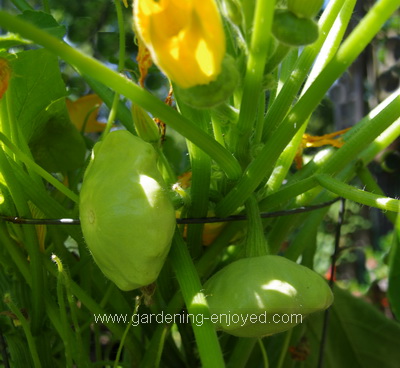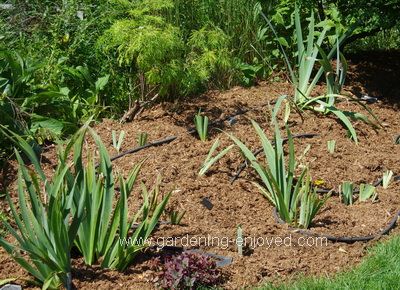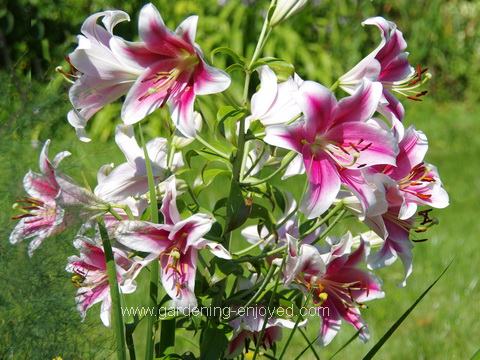| Back to Back Issues Page |
 |
|
Dallying In The Dirt, Issue #298 - Pink Brilliant is an amazing LO Hybrid lily July 30, 2017 |
 Patty Pan squash are lovely to look at and their large yellow flowers add even more interest to a beautiful vegetable plant. They are a summer squash that I grow and treat just like a Zucchini except when I’m cooking them. Most times they are chopped into a stir fry or used raw in a salad but if I cut them in half in either direction and then scoop out the central seedy bit then I’m left with a nice little cavity. Some chopped sweet Peppers mixed with a little curry paste can fill that cavity and then spend enough time on the BBQ to just soften their flesh. Delightful. This plant is growing in a container and is supported by a Tomato cage. I visit this plant and all the similar ones every morning to check the inside of the flowers for Cucumber Beetles and if there are any dozing in there they get a bath of insecticidal soap. My morning diligence
this year has kept the damage from those nasty striped bugs to a minimum. I’m in that frequent mid summer quandary of what to do with a surfeit of Zucchini. The Assistant Gardener watches me come in each morning carrying another few and wonders just what she might do with them or if her dinner is going to be mostly Zucchini served in a variety of ways. Today the daughter was the lucky recipient of the day’s harvest and she did a great job of appearing enthusiastic about them.
Patty Pan squash are lovely to look at and their large yellow flowers add even more interest to a beautiful vegetable plant. They are a summer squash that I grow and treat just like a Zucchini except when I’m cooking them. Most times they are chopped into a stir fry or used raw in a salad but if I cut them in half in either direction and then scoop out the central seedy bit then I’m left with a nice little cavity. Some chopped sweet Peppers mixed with a little curry paste can fill that cavity and then spend enough time on the BBQ to just soften their flesh. Delightful. This plant is growing in a container and is supported by a Tomato cage. I visit this plant and all the similar ones every morning to check the inside of the flowers for Cucumber Beetles and if there are any dozing in there they get a bath of insecticidal soap. My morning diligence
this year has kept the damage from those nasty striped bugs to a minimum. I’m in that frequent mid summer quandary of what to do with a surfeit of Zucchini. The Assistant Gardener watches me come in each morning carrying another few and wonders just what she might do with them or if her dinner is going to be mostly Zucchini served in a variety of ways. Today the daughter was the lucky recipient of the day’s harvest and she did a great job of appearing enthusiastic about them. This planting of Iris on the back berm actually tells a bigger story. There were several new Iris put there a couple of years ago and they did very well. The mulch did keep the weeds to a minimum but this year much of the mulch slid down the slope and allowed more weeds to grow. Weeds are the big part of this story. They have become overwhelming this year as the constant rain made them grow enthusiastically and prevented me from getting into garden to chase them. Every day that I spend doing something other than chasing weeds has started to make me feel guilty and that’s not the purpose of the garden. Between the, impossible to stop, weeds and the rapidly passing birthdays I have decided that I will really spend this summer and fall greatly reducing the area of garden that I have to maintain. Lots of planning is going into this reduction as it’s difficult to give up some of my prized plant collections and that
leads me back to the picture. Several more Iris have been dug from the beds that are being reduced and then planted on that berm with a generous application of shredded cedar mulch. Another small circular bed across from it is also losing everything but Iris and one or two Daylilies. The two main beds in the back yard will be retained in as small a shape as possible to preserve the Asparagus with some Daylilies in between. The large and very overgrown fence bed will become just a shrub border with landscape fabric and lots of mulch to make it as maintenance free as possible.
This planting of Iris on the back berm actually tells a bigger story. There were several new Iris put there a couple of years ago and they did very well. The mulch did keep the weeds to a minimum but this year much of the mulch slid down the slope and allowed more weeds to grow. Weeds are the big part of this story. They have become overwhelming this year as the constant rain made them grow enthusiastically and prevented me from getting into garden to chase them. Every day that I spend doing something other than chasing weeds has started to make me feel guilty and that’s not the purpose of the garden. Between the, impossible to stop, weeds and the rapidly passing birthdays I have decided that I will really spend this summer and fall greatly reducing the area of garden that I have to maintain. Lots of planning is going into this reduction as it’s difficult to give up some of my prized plant collections and that
leads me back to the picture. Several more Iris have been dug from the beds that are being reduced and then planted on that berm with a generous application of shredded cedar mulch. Another small circular bed across from it is also losing everything but Iris and one or two Daylilies. The two main beds in the back yard will be retained in as small a shape as possible to preserve the Asparagus with some Daylilies in between. The large and very overgrown fence bed will become just a shrub border with landscape fabric and lots of mulch to make it as maintenance free as possible. The upside of all of this renovation belongs to friends, neighbours and readers of “Dallying.” There will be a significant quantity of surplus plants to dispose of. The plan is to have a sale in mid August, dates will be publicized, with the hope of raising just enough money to pay for the sod that will be needed to cover the area where these weed beds are currently causing me such stress. There are already about a dozen Iris varieties looking for homes. Doesn’t grass take some maintenance, you ask? Well yes but the Assistant Gardener likes cutting grass !! That should me leave me lots of time to write “Dallying” and other similar activities. Now it’s time to answer a few of my reader’s questions. To ask a question just “reply” to this ezine. Don’t forget to check the front page of the Website for frequent short ideas for current gardening activities. Elizabeth Asks? My house kept only benjamina tree have some really sticky leaves. Any explanation what it is and if I need to do anything about it? Michele Asks? I am thoroughly enjoying your newsletters and it suddenly occurred to me I should be asking you if you have any thought on why my clematis plants are doing so poorly. I have their trellises on a west facing wall (which is the only location in my yard which gets much sun—sun from 11 am - 5 pm). All are just barely hanging on, but the purple Jackmani has for the last couple years grown nicely, had a few flowers and then suddenly turned brown and died right off. I must admit I do not fertilize on a regular basis, the soil over the roots is mulched w
about an inch of bark chips. This happened again just two weeks ago, although we were having lots of rain, so what gives? |
| Back to Back Issues Page |
